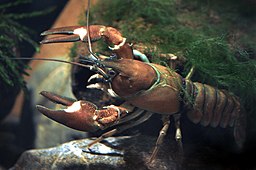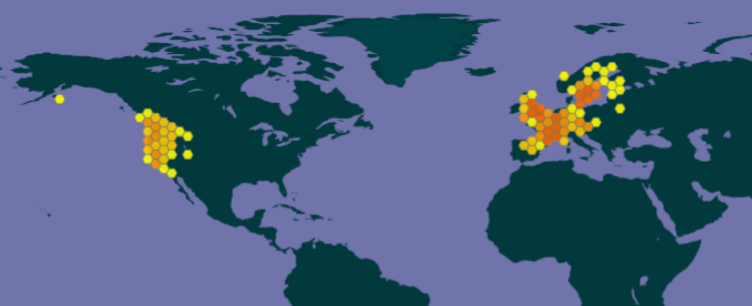 |
Signal crayfish | Status LU: established. 1st record: 1996. |
 |
Signalkriibs | Status Eur.: established. IAS of EU concern. |
 |
Écrevisse de Californie | RA: ISEIA: A3, Black List. Harmonia+: n/a. |
 |
Signalkrebs | Wikipedia:     | Wikispecies: n/a (2020) | Wikispecies: n/a (2020) |
 |
Signaalkreeft | Back to the list of invertebrates |
Contents
Report the species
→ Report Pacifastacus leniusculus to the National Museum of Natural History.
Brief description

The signal crayfish is an omnivore, with most of its dietary intake being detritus. Members of this species are typically 6–9 centimetres long, although sizes up to 16–20.32 centimetres are possible. They are bluish-brown to reddish-brown in colour, with robust, large, smooth claws. They have a white to pale blue-green patch near the claw hinge, like the white flags that signalmen used for directing trains—hence the name. Around 200–400 eggs are laid after mating in the autumn, and are carried under the female’s tail until they are ready to hatch the following spring. The eggs hatch into juveniles, which pass through three stages (two moults) before leaving their mother. Sexual maturity is reached after two to three years, and the lifespan can be up to 20 years (Wikipedia contributors 2020).
Status and distribution in Luxembourg
Records of Pacifastacus leniusculus Dana 1852 in Luxembourg. Data source: Recorder-Lux, iNaturalist & GBIF, 2024-10-22.
1020 occurrences of Pacifastacus leniusculus Dana, 1852 are documented in the Recorder-Lux database, the first from 1996 (MNHNL, iNaturalist & GBIF, 2020). The species has been present in Luxembourg since much earlier though. Dhur & Massard (1995) describe stockings of P. leniusculus in the lake of Esch/Sûre (1972), Kriibseweier/Gonderange (1974, 1975, 1976), Attert, Wark, Tandlerbaach, Dirbach, ponds at Kockelscheuer and Gostingen, the lake in Echternach, the Sûre close to Wallendorf and the Syre, ranging from 1977 to 1986.
Management
Action plan
An action plan regarding Pacifastacus leniusculus (and Faxonius limosus) has been published in 2020:
→ Finalised Action Plan for Pacifastacus leniusculus (De Sousa 2020)
Risk assessment
ISEIA protocol
A3 (3+3+3+2) = Black List (Ries et al. 2017: 68).
Harmonia+ protocol
Not assessed yet.
Worldwide distribution
Fact sheet
PDF fact sheet of the Nature and Forestry Administration: FR | DE
Bibliography
- Administration des eaux et forêts, Service de la chasse et de la pêche, 1998. Fische in Luxemburg. Kartierung der Fische, Neunaugen und Flußkrebse des Großherzogtums Luxemburg. ISBN 2-495-28004-8. 153 pp.
- Administration de la gestion de l’eau, 2010. Les poissons au Luxembourg, Cartographie des poissons, lamproies et écrevisses du grand-duché de Luxembourg. 2e édition. ISBN 978-2-91989-713-1. 213 pp.
- Atten, D., 1987. Étude des populations d’Ecrevisses d’eau douce au grand-duché de Luxembourg et spécialement de l’Écrevisse de Californie. Luxembourg, Mémoire sci. asp. prof., 190 pp.
- De Sousa, Tiago, 2020. Plan d’action pour espèces exotiques envahissantes au Grand-Duché de Luxembourg: l’Écrevisse signal, Pacifastacus leniusculus (Dana, 1852) et l’Écrevisse américaine, Faxonius limosus (Rafinesque, 1817). Version 4/09/2020. Administration de la nature et des forêts, Luxembourg. 29 pp.
- Dhur, G. & J.A. Massard, 1995. Étude historique et faunistique des Invertébrés immigrés ou introduits dans la Moselle luxembourgeoise et ses affluents. Bull. Soc. Nat. luxemb. 96: 127-156. [PDF 1896 KB]
- GBIF, 2020. Pacifastacus leniusculus (Dana, 1852) in GBIF Secretariat (2019). GBIF Backbone Taxonomy. Checklist dataset https://doi.org/10.15468/39omei [accessed 2020-03-13]
- Meisch, C. & J.A. Massard, 2015. Les recherches sur les crustacés (Crustacea) du Luxembourg : aperçu historique. Bull. Soc. Nat. luxemb. 116: 381-390.
- MNHNL, iNaturalist & GBIF, 2020. Pacifastacus leniusculus in MNHNL-mdata, online portal combining species observation from Recorder-Lux, iNaturalist and GBIF. National Museum of Natural History, Luxembourg. URL: https://mdata.mnhn.lu [accessed 2020-03-13]
- Ries, C., A. Arendt, C. Braunert, S. Christian, A. Dohet, A. Frantz, G. Geimer, M. Hellers, J. A. Massard, X. Mestdagh, R. Proess, N. Schneider & M. Pfeiffenschneider, 2017. Environmental impact assessment and black, watch and alert list classification after the ISEIA Protocol of invertebrates in Luxembourg. Bull. Soc. Nat. luxemb. 119: 63-70. [PDF 360 KB]
- Wikipedia contributors, 2020. ‘Signal crayfish’, Wikipedia, The Free Encyclopedia, 31 January 2020, 01:54 UTC, <https://en.wikipedia.org/w/index.php?title=Signal_crayfish&oldid=938417407> [accessed 2020-03-13]
Suggested citation of this webpage
Ries, C. & M. Pfeiffenschneider (Eds.), 2024. Pacifastacus leniusculus Dana, 1852. In: neobiota.lu - Invasive Alien Species in Luxembourg. National Museum of Natural History, Luxembourg. URL: https://neobiota.lu/pacifastacus-leniusculus/ [Accessed 2024-10-22].
Page content last updated on 2024-07-31. Last proofread by Caroline Grounds on 2019-12-11.


